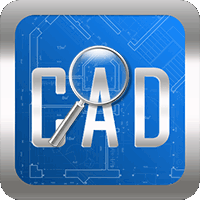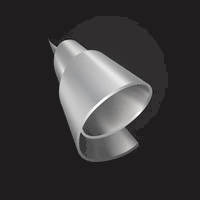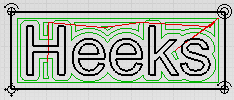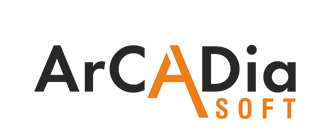Most CAD software can be accessed from multiple devices and platforms. With the advancement of technology, many CAD software now provide cloud-based services, allowing users to access their projects from any internet-connected device. Furthermore, many CAD software is compatible with a variety of operating systems, including Windows, Mac, and Linux, making it convenient to use across multiple devices. This provides greater flexibility and accessibility for designers and engineers working on projects remotely or on the go.
List of 20 Best CAD Software
XienceSim is an advanced finite element simulation software, perfect for solving multi-physics problems in the Semiconductor Physics domain. Our user-friendly interface, integrated geometry builder, and automatic mesher make modeling effortless. Take...Read More XienceSim
Elysium 3DxSUITE is a 3D data translation, optimization, and validation software. This powerful tool allows for effortless collaboration across various CAD systems and enhances productivity with advanced error-checking and data management capabilitie...Read More Elysium 3DxSUITE
CADWorx is a leading CAD software designed specifically for plant design. Our comprehensive set of tools covers all aspects of piping, structural, and equipment design. Its seamless integration with analysis and drafting tools increases productivity...Read More CADWorx
CAD Processor, an advanced software that streamlines the preparation and simplification of 3D reference data for specialized downstream applications. With its user-friendly interface, users can quickly simplify and analyze complex parts and assemblie...Read More CAD Processor
CAD Reader is aversatile and intuitive software designed for viewing and measuring CAD drawings. With support for *.dwg/*.dxf files, this lightweight tool allows for effortless annotation and accurate measurements. Simplify your CAD viewing experienc...Read More CAD Reader
Stallion 3D, an advanced software equipped with cutting-edge modeling features, flawless rendering, and user-centric design tools. Designed for experts, it unleashes limitless creativity, simplifies processes, and ensures precision in intricate proje...Read More Stallion 3D
Experience the innovative power of ANSYS SpaceClaim is asoftware revolutionizing the field of design and engineering. With its intuitive and flexible modeling capabilities, it streamlines workflows and accelerates prototyping. Promoting seamless coll...Read More ANSYS SpaceClaim
Bridge Designer solution for creating complex bridge models effortlessly. Our software features an easy-to-use interface and advanced simulation technology to streamline the design process and deliver accurate results for engineers and students. Elev...Read More Bridge Designer
AutoDCR is a software specifically created to simplify the approval procedure for building plans. This revolutionary system utilizes automation to efficiently validate plans in compliance with local regulations. With its advanced capabilities, AutoDC...Read More AutoDCR
ESPRIT is a highly versatile software designed to enhance CNC programming, simulation, and optimization. Its intuitive interfaces, coupled with high precision and reduced machining time, make it a valuable asset for manufacturers. With compatibility...Read More ESPRIT
3D Crafter, the premier software for crafting stunning 2D and 3D designs. With a user-friendly drag-and-drop interface, creating lines, meshes, and arches has never been easier. Thanks to its free and open-source capabilities, bringing your visions t...Read More 3D Crafter
Autodesk Architecture is a software for designing, documenting, visualizing, and simulating projects. This robust tool empowers users to produce top-notch and cutting-edge designs while facilitating seamless collaboration and project communication. W...Read More Autodesk Architecture
CAD Exchangeris a CAD converter with over 30 supported file formats including Parasolid, SOLIDWORKS, STEP, and IFC. Easily convert and visualize 3D models, take precise measurements, create cross-section views, and more. Your CAD workflow just got fa...Read More CAD Exchanger
HeeksCNC is CAD software created in Python, designed to meet all your machining needs. It offers a wide range of features such as CAD mesh, drilling, profile, and pocket operations. Its seamless integration with other programs allows for easy import...Read More HeeksCNC
SALOME: a user-friendly Pre- and Post-Processing software designed to streamline numerical simulations. Its open-source CAD capabilities foster seamless collaboration between design and computational tools. Perfect for engineers, researchers, and stu...Read More SALOME
Pacdora is a packaging design solution. Our user-friendly tool offers a drag-and-drop editor and advanced rendering options to help you effortlessly create custom packaging designs. We also provide integrated printing services, making it easy to brin...Read More Pacdora
ArCADia BIM 12 solution for creating precise architectural and construction models. With this software, you can effortlessly design a comprehensive building representation, complete with internal and external installations and terrain modeling. ArCAD...Read More ArCADia BIM 12
RouterCAD is a software designed specifically for cabinet makers. Its intuitive interface and professionally designed templates simplify and streamline the cabinet design process, ensuring precise results. Ideal for woodworking projects, it also seam...Read More RouterCAD
SolveSpace - the leading free and open-source CAD software in the market. With its robust features, users can effortlessly create 2D and 3D designs at a budget-friendly cost. From producing precise dimensioned drawings to generating CAM data, SolveSp...Read More SolveSpace
Vectorworks Architect - your ultimate design solution for taking your projects from concept to BIM. With a range of powerful tools, this comprehensive software suite empowers you to bring your ideas to life seamlessly and efficiently. Collaborate in...Read More Vectorworks Architect
Learn More About CAD Software
- What Is CAD Software?
- What Are The Recent Trends In CAD Software?
- Benefits Of Using CAD Software
- Important Factors To Consider While Purchasing CAD Software?
- What Are The Key Features To Look For In CAD Software?
- Why Do Businesses Need CAD Software?
- How Much Time Is Required to Implement CAD Software?
- What Is the Level of Customization Available in CAD software?
- Which Industries Can Benefit The Most From CAD Software?
- Conclusion
What Is CAD Software?
CAD (Computer-Aided Design) software allows architects, engineers, product designers, and other professionals to create precise and detailed 2D and 3D models of objects and structures. This allows users to visualize their concepts, make changes, and test various design options before beginning the physical production process.
One of the most important features of CAD software is its ability to accurately represent the real-world dimensions and constraints of a design. This enables precise measurements and calculations, resulting in extremely accurate and dependable designs. In addition to creating detailed models, CAD software provides a variety of tools for analyzing and simulating designs, including stress analysis for structural components, fluid dynamics for architectural designs, and product lifecycle management for effective collaboration and project management.
CAD software also includes a variety of intuitive and user-friendly tools for manipulating and editing designs, allowing for simple changes and adjustments. This is especially useful for complex designs that require numerous iterations. Another advantage of CAD software is its compatibility with a variety of file formats, which allows for easy import and export of designs between programs.
This facilitates and streamlines collaboration and communication with clients and stakeholders.When selecting CAD software, you must consider the unique needs and requirements of your industry and project. Look for features such as 2D and 3D modeling, simulation and analysis tools, compatibility with industry-standard formats, and an easy-to-use interface. AutoCAD, SolidWorks, and Fusion 360 are among the most popular CAD software on the market today.
Consider using demos or free trials to find the best solution for your needs. With the right CAD software, you can bring your designs from concept to completion with accuracy, efficiency, and precision.
What Are The Recent Trends In CAD Software?
In the field of design and engineering, CAD (Computer-Aided Design) software has become an indispensable tool for both professionals and businesses alike. The CAD software landscape is constantly changing as technology advances. In this buyer's guide, we will go over recent trends in CAD software, allowing you to make an informed decision when purchasing the best software for your requirements.
1. Integration with Other Software: One of the most significant trends in CAD software is its integration with other applications and platforms. The rise of cloud computing has made CAD software more accessible and compatible with other tools, such as project management software and virtual reality platforms. This integration enables more seamless workflow and collaboration across multiple teams and projects.
2. Focus On 3D Modeling: Another trend in CAD software is a greater emphasis on 3D modeling capabilities. While 2D drafting is still essential, 3D modeling is becoming increasingly popular, particularly in industries such as architecture, manufacturing, and product design. Advanced 3D modeling tools are increasingly being integrated into CAD software, allowing designers and engineers to create realistic and accurate virtual models of their projects.
3. Mobile Compatibility: As the number of mobile devices grows, so does the accessibility of CAD software. Many CAD software packages now include apps that allow users to access and work on their designs while on the go, making it easier to collaborate and make changes on-site. This trend is especially useful for fieldwork, as designers and engineers can quickly sketch ideas and make necessary revisions in real time.
4. Artificial Intelligence And Automation: CAD software is increasingly incorporating artificial intelligence and automation technologies to improve design efficiency and accuracy. These features can help with repetitive tasks like standardizing parts and components, reducing the time and effort required by designers to complete their projects. The use of artificial intelligence in CAD software improves design accuracy and precision.
5. Adopting Open-Source Software: With the proliferation of open-source software, CAD software is no exception. Many businesses are embracing this trend by providing free or low-cost CAD software that is constantly updated by a community of users and developers. This not only makes the software more affordable, but also gives users more control over its features and development.
Benefits Of Using CAD Software
CAD (Computer-Aided Design) software has become an indispensable tool for designers, engineers, and architects. It allows users to quickly and easily create and optimize precise 2D and 3D designs. The advantages of using CAD software go beyond simply creating digital designs, making it an excellent investment for professionals in a variety of industries.
1. Improved Design Quality: CAD software provides a variety of tools and features for creating accurate and detailed designs. From precise measurements to real-time rendering, CAD software enables users to create designs that are both visually appealing and technically sound. This improves design quality, reduces errors, and ensures that projects are completed precisely.
2. Time And Cost Efficiency: In the world of design and engineering, time is critical. The use of CAD software significantly speeds up the design process, saving professionals time and effort. With automated features and tools, tasks that would normally take hours to complete manually can now be completed in minutes. This not only saves time but also lowers labor costs, making CAD software an economical choice for businesses.
3. The Ease Of Collaboration: CAD software's collaborative nature makes it an ideal tool for teams working on a single project. CAD software facilitates team communication and collaboration by providing real-time access to designs and the ability to make changes at the same time. This leads to faster project completion and improved teamwork.
4. Flexibility And Versatility: CAD software is extremely versatile, making it applicable to a wide range of industries and professionals. From architecture and construction to industrial and mechanical design, CAD software can be tailored to meet the unique requirements of various industries. This adaptability makes it an invaluable tool for professionals from various fields, ensuring that their design requirements are met effectively.
5. Improved Visualization And Presentation: CAD software allows for the visualization of designs in both 2D and 3D, providing clients and stakeholders with a better understanding of the finished product. This enables better idea presentation and communication, which leads to increased client satisfaction and confidence in the project.
Important Factors To Consider While Purchasing CAD Software?
When it comes to purchasing CAD software, it can be a daunting task with so many options available in the market. As a buyer, it is important to consider certain factors before making a decision to ensure that you get the best software for your needs.
Here are some essential factors to keep in mind while purchasing CAD software:
1. Compatibility: The first and foremost factor to consider is the compatibility of the CAD software with your computer's operating system and hardware. Make sure the software is compatible with your computer to avoid any technical issues and ensure a smooth working experience.
2. Features And Tools: Different CAD software offers various features and tools, and it's crucial to determine what specific features and tools you need for your projects. Consider your requirements, such as 2D or 3D designing, rendering capabilities, and file compatibility, before making a decision.
3. User-Friendliness: The CAD software should have a user-friendly interface, making it easy for you to navigate and use. It should also have a learning curve that is suitable for your level of expertise.
4. Training And support: Purchasing CAD software is just the first step. It's essential to consider the availability of training and support resources that can help you learn and use the software effectively. Look for options such as tutorials, online guides, and customer support services.
5. Price And Budget: CAD software can range from free to expensive, and it's important to consider your budget before making a choice. While it may be tempting to opt for a cheaper option, consider the long-term benefits and features that you will get with a more expensive software.
6. Updates And Upgrades: CAD software is constantly evolving, and it's crucial to consider the availability of updates and upgrades for the software. Check if the software offers regular updates and if you need to pay for any upgrades.
7. Reviews And Ratings: Before purchasing any CAD software, it's advisable to research and read reviews and ratings from other users. This will give you an insight into their experiences and help you make an informed decision. By keeping these factors in mind, you can make the best choice when purchasing CAD software. Remember to thoroughly research and compare different options before making a decision. With the right CAD software, you can bring your design ideas to life and improve your productivity and efficiency.
What Are The Key Features To Look For In CAD Software?
When looking for CAD software, it is critical to understand which features to prioritize before making a purchase. The software market is flooded with options, making it difficult to determine which one will best suit your needs.
To assist you in making an informed decision, here are the key features to look for in CAD software:
1. User-Friendly Interface: The first factor to consider is ease of use. A user-friendly interface makes learning easier and workflow more efficient. Look for software with a simple, well-organized interface and user-friendly features.
2. 2D And 3D Capabilities: CAD software must support both 2D and 3D drafting. This enables the creation of detailed and precise designs, ranging from simple layouts to complex models.
3. Support For Multiple File Formats: CAD software should be able to import and export a variety of file formats, including DXF, DWG, and PDF. This is critical when working with clients, contractors, and team members who may use different software.
4. Advanced Modeling Tools: A good CAD software should include a variety of modeling tools, from basic shapes to more advanced tools such as parametric modeling, solid modeling, and surface modeling. These tools are useful for creating precise and complex designs.
5. Customization Options: Each designer has unique preferences and working styles. To improve your workflow, look for software that allows you to customize things like toolbars, shortcut keys, and user-defined commands.
6. Collaboration And Sharing Capabilities: In today's digital age, collaboration is essential. Look for CAD software that supports real-time collaboration with team members, allowing for more efficient design sharing and feedback.
7. 3D Printing Support: CAD software that supports 3D printing is useful, particularly for product design. It enables the development of prototypes directly from the software, saving time and effort.
8. Software Compatibility: Many designers use multiple applications for various tasks, such as rendering and animation. Consider CAD software that is compatible with other programs, allowing for faster and more efficient file transfers.
9. Technical Support And Training: CAD software, like any other software, can have technical issues. Look for a company that provides technical support and training to ensure smooth operation and troubleshooting.
10. Cost: Finally, think about the cost of the software. While some CAD software is more expensive, it may be worth the investment due to its advanced features. On the other hand, some software provides free or low-cost options with basic features that may be appropriate for small projects.
Why Do Businesses Need CAD Software?
Businesses require CAD software to improve productivity and efficiency in their design and engineering processes. With its powerful tools and features, CAD software enables businesses to create precise and detailed 2D and 3D designs, as well as simulate and analyze their products prior to production. Businesses that use CAD software can significantly reduce the time and cost of design and prototyping while also eliminating the risk of errors and miscalculations.
This not only saves resources, but also reduces product time to market, providing businesses with a competitive advantage. Additionally, CAD software allows businesses to effectively collaborate and communicate with their team members and clients. Businesses can make faster decisions and accelerate the approval process by being able to share and review designs in real time.
Furthermore, CAD software allows businesses to keep a digital archive of all their designs, making it easier to find and reuse previous designs for similar projects. This saves time while also ensuring consistency in design and branding. Furthermore, CAD software allows businesses to quickly adapt to changes and modifications in their designs.
With the ability to make real-time edits and iterations, businesses can meet tight deadlines and accommodate customer feedback, resulting in higher customer satisfaction. Overall, investing in CAD software is critical for businesses to remain competitive in today's fast-paced and demanding marketplace. It not only makes the design process easier, but it also helps businesses stay organized, efficient, and innovative. Businesses can achieve success by selecting the appropriate CAD software for their design and engineering needs.
How Much Time Is Required to Implement CAD Software?
The time required to implement CAD software varies according to the software and the project's complexity. The implementation process can last anywhere from a few days to several months. However, the more time and effort you put into the implementation process, the faster and easier the transition will be for your team. Before beginning the implementation process, it is critical to have a thorough understanding of your company's requirements and objectives.
This will help determine which CAD software is best suited and how much time will be required for implementation. It is also critical to include key stakeholders in the decision-making process, such as designers and engineers, to ensure their needs are addressed. The first step in implementation is typically installation and configuration. This typically entails installing the software on computers and making sure it is properly configured for your company's requirements.
This process can take anywhere from a few hours to a full day, depending on the number of users and the software's compatibility with your system. After installing the software, the next step is to train your team on how to use it. This can be accomplished using online tutorials or training sessions provided by the software company. The duration of training will be determined by the software's complexity and your team's proficiency.
Following training, integrate the software into your company's workflow and processes. This may entail customizing the software to meet your specific requirements, such as creating templates and establishing workflows. This process could take a week or longer, depending on the level of customization required. Finally, test the software and make any necessary changes before fully implementing it.
This may include conducting project trials or working on sample designs to ensure that the software works as expected. The testing phase can last from a few days to a few weeks, depending on the size and complexity of your project.
What Is the Level of Customization Available in CAD software?
CAD (Computer-Aided Design) software is a must-have tool for professionals in architecture, engineering, construction, and other industries that require design and drafting. The ability to customize software to meet an organization's specific needs and workflows is critical for increasing productivity and efficiency.
In this buyer's guide, we'll go over the level of customization available in CAD software and help you make an informed decision when choosing the best software for your business. CAD software is highly customizable, allowing users to tailor the interface, tools, and features to their specific preferences and needs. The extent of customization options varies by software, but most leading CAD programs offer a diverse set of customization tools.
One of the most common ways to customize CAD software is to change the user interface. This includes adjusting the layout, colors, and workspace to reflect the user's preferences. Some software also lets you create custom tool palettes and menus to quickly access frequently used commands. In addition to the interface, users can customize the software's tools and features.
This can include creating macros or scripts for repetitive tasks, designing custom templates and styles, and establishing default settings for new drawings. CAD software also allows you to add third-party plug-ins and extensions to expand its functionality. Another important aspect of CAD software customization is its ability to integrate with other software and systems within the organization.
This enables seamless data exchange and collaboration among different departments or teams. Many CAD programs include APIs (Application Programming Interfaces) that enable developers to create custom integrations based on the user's requirements. The level of customization available in CAD software extends beyond the features listed above.
Advanced users with programming knowledge can further customize the software by writing code in programming languages such as AutoLISP and Visual Basic. This opens up limitless possibilities for developing custom tools and workflows that are tailored to the organization's specific requirements.
Which Industries Can Benefit The Most From CAD Software?
CAD software, or computer-aided design software, has evolved into an indispensable tool for many modern industries. With its precision, efficiency, and versatility, CAD software has transformed how businesses and professionals design, simulate, and communicate their ideas. In this buyer's guide, we'll go over the key industries that can benefit the most from CAD software, allowing you to make an informed decision when selecting the best software for your requirements.
1. Architecture And Construction: The architectural and construction industries rely heavily on CAD software to design and create blueprints, floor plans, and 3D models of buildings and structures. CAD software allows architects and designers to easily visualize their concepts, make quick changes, and collaborate with other professionals in real time. This not only saves time, but also reduces the possibility of errors and miscommunications, resulting in more effective project management.
2. Engineering Industry: The engineering industry, like the architecture and construction industries, relies heavily on CAD software to design and analyze products and systems. Engineers use CAD software to create detailed 2D and 3D models, simulate them, and conduct stress tests to ensure that their designs are functional and safe. This aids in identifying and addressing potential issues during the design phase, saving time and resources in the manufacturing stage.
3. Automotive Industry: The automotive industry has also undergone significant transformation since the introduction of CAD software. Car manufacturers use CAD software to design and prototype their vehicles, including the engine and chassis as well as the interior and exterior components. This simplifies the design process, reduces production costs and time, and enables faster innovation and introduction of new models.
4. Manufacturing Industry: The manufacturing industry is another major user of CAD software. Manufacturers use CAD software to create precise and detailed designs that guide the manufacturing process for a variety of products, including consumer goods and industrial machinery. With the ability to input manufacturing specifications, CAD software ensures that the final product is accurate and consistent, reducing waste while increasing productivity.
5. Product Design Industry: Product designers rely heavily on CAD software to make their ideas a reality. With the ability to create detailed 3D models, designers can visualize and refine their designs, test for product functionality and aesthetics, and even show the finished product to clients and investors. This not only saves time, but it also increases the likelihood of product success on the market.
Conclusion
After conducting extensive research and analysis of various CAD software options, we concluded that investing in a dependable and user-friendly CAD software is critical for any business or individual looking to streamline their design process and produce high-quality, precise drawings. Throughout this buyer's guide, we've covered the key features to look for in CAD software, including 2D and 3D modeling capabilities, file format compatibility, and collaboration tools.
We've also emphasized the importance of taking into account your specific requirements and budget before making a decision. According to our research, the top CAD software options are AutoCAD, SolidWorks, and SketchUp. These programs provide a diverse set of features and tools that can meet a variety of design requirements. However, it is critical to carefully evaluate your specific requirements before selecting the software that best meets your needs and budget.
It is also important to consider the level of technical support and training provided by the CAD software provider. A user-friendly interface and dependable support can significantly improve the success of your design projects. To summarize, investing in the right CAD software can significantly improve the efficiency and accuracy of your design process, resulting in higher-quality products and increased productivity.
By carefully considering your needs and budget, as well as thoroughly researching the available options, you can make an informed decision and select the CAD software that best meets your requirements. We hope this buyer's guide has provided useful information and assisted you in your search for the ideal CAD software.
CAD Software FAQ's
Can CAD Software Be Accessed Across Multiple Devices And Platforms?
Is CAD Software Future-Proof And Adaptable to Emerging Technologies Like Ai, Blockchain or Iot?
CAD software is constantly evolving and adapting to new technologies, making it future-proof and capable of keeping up with emerging trends such as artificial intelligence, blockchain, and the Internet of Things. Many CAD software companies have already implemented AI capabilities for tasks such as 3D model generation and optimization. Furthermore, CAD software is integrating with blockchain for secure collaboration and utilizing IoT for real-time data analysis and virtual simulations. As technology advances, CAD software will need to be more flexible and adaptable to remain relevant in the design industry.
Is There A Free Trial Offered to Assess CAD Software Before Committing?
Yes, most CAD software companies provide a free trial period for users to evaluate the software before making a purchase. The duration can range from a few days to a month, depending on the company. The free trial allows users to test the software's features and capabilities and determine whether it meets their needs. It is an excellent opportunity for users to assess the software's usability, performance, and compatibility before making a commitment.
Does CAD Software Offer Data Security Features And Meet Regulatory Compliance Standards?
CAD software typically provides data security features such as built-in encryption and access controls to protect sensitive design files. It frequently meets regulatory compliance standards such as GDPR, HIPAA, and ISO 27001. Users can be confident that their designs are secure and meet industry standards, protecting the integrity of their work.
Can CAD Software Integrate Seamlessly With Existing Tools And Platforms?
Most CAD software is designed to work seamlessly with existing tools and platforms. This ensures a smooth workflow and communication among various software systems. CAD software typically supports a variety of standard file formats, making it simple to import and export designs to and from multiple platforms. Furthermore, many CAD software packages include plugins and extensions that allow for additional integration with other tools and platforms, resulting in increased functionality and efficiency.






















